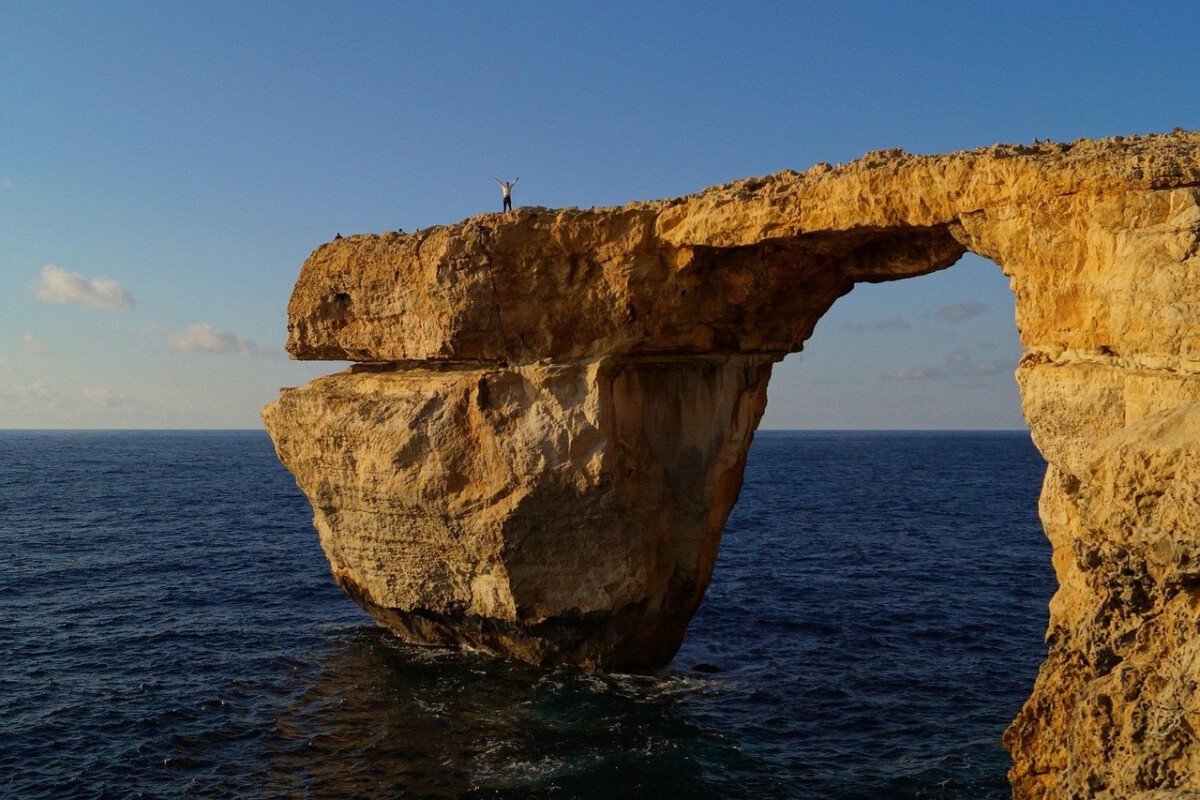The Enchanting Island of Gozo, Malta

Tucked away to the northwest of Malta, Gozo feels like a secret whispered only among true travelers. Unlike the bustling streets of Valletta, Gozo’s winding lanes are lined with honey-colored stone houses, sleepy villages, and a sense of peace that’s hard to find elsewhere. Although the iconic Azure Window collapsed in 2017, Gozo’s Ġgantija Temples, one of the world’s oldest freestanding structures, continue to inspire awe. The island is a diver’s paradise, with the Blue Hole and Inland Sea drawing underwater explorers from across the globe. According to the Malta Tourism Authority, Gozo receives around 1.5 million visitors each year, but many still overlook its understated magic. The island’s laid-back atmosphere, artisanal cheese, and dramatic coastal cliffs make it a perfect antidote to the hectic Mediterranean hotspots. Walking through Gozo, you’ll feel like you’ve stepped back in time, discovering a side of Malta that’s gentle, untouched, and deeply authentic.
The Serene Beaches of Elafonissi, Crete

Elafonissi Beach, located on the southwestern tip of Crete, looks almost otherworldly with its blush-pink sands and shimmering turquoise waters. The sand’s unique hue comes from millions of crushed seashells, making every step feel like a stroll through a fairy tale. Unlike the crowded beaches of Heraklion or Chania, Elafonissi offers a tranquil escape, especially outside peak summer months. The shallow, warm waters are ideal for families, while the nearby nature reserve is home to endangered flora and migratory birds. According to the Hellenic Statistical Authority, Crete hosted over 4.5 million tourists in 2022, but Elafonissi’s relative remoteness keeps it blissfully peaceful. Sunsets here are magical, casting a soft glow over the lagoon and creating an unforgettable scene. For those seeking relaxation and natural beauty, Elafonissi is a must-visit gem hiding in plain sight.
The Picturesque Village of Civita di Bagnoregio, Italy

Civita di Bagnoregio sits perched atop a crumbling hill in Italy’s Lazio region, earning it the haunting nickname “the dying town.” Accessible only by a long pedestrian bridge, this medieval marvel feels frozen in time. With a population of just 12 residents, the village’s narrow cobblestone alleys and ancient stone houses offer a captivating glimpse into Italy’s past. The dramatic cliffs that surround Civita have been slowly eroding, adding both a sense of urgency and wonder to any visit. Despite attracting around 600,000 visitors annually (according to the Italian National Institute of Statistics), Civita remains quiet, especially outside weekends and holidays. The village’s timeless beauty, vibrant flower boxes, and panoramic views of the Tiber Valley create a stunning, almost storybook setting. Wandering through Civita, you can’t help but feel a sense of nostalgia and awe for a place that seems to defy the march of time.
The Untouched Beauty of Kotor, Montenegro

Nestled at the end of a fjord-like bay, Kotor’s medieval streets are flanked by soaring mountains and sparkling blue waters. Unlike the crowded resorts along the Adriatic, Kotor offers a quieter, more authentic experience. Its UNESCO-listed old town is a labyrinth of stone lanes, hidden squares, and centuries-old churches dating back to the 9th century. Climbing the ancient city walls rewards visitors with breathtaking views of the bay, a panorama that feels almost surreal in its beauty. According to tourism data, Kotor saw over 1 million visitors in 2022, but off-season months still provide moments of rare solitude. The blend of Venetian architecture and Montenegrin tradition gives Kotor a unique charm. It’s a place where history and nature meet, and every corner seems to offer another surprise waiting to be discovered.
The Charming Streets of Mdina, Malta

Mdina, often called the “Silent City,” is a fortified jewel set high above the Maltese countryside. Once Malta’s capital, Mdina’s narrow streets and impressive medieval walls create an atmosphere that’s both tranquil and mysterious. The city’s baroque palaces and St. Paul’s Cathedral stand as testaments to centuries of layered history. Despite its historical significance, Mdina draws fewer crowds than Malta’s coastal towns, with about 1 million visitors a year as reported by the Malta Tourism Authority. Wandering its quiet alleyways, you’ll hear nothing but the echo of your footsteps on ancient stones. The views from the city’s ramparts stretch across golden fields to the distant sea, offering a peaceful escape from modern life. Mdina’s magic lies in its stillness, allowing travelers to slow down and savor the beauty of the past.
The Scenic Beauty of Visby, Sweden

While Sweden isn’t the first place that springs to mind for Mediterranean escapes, the island of Gotland and its main town Visby are true northern gems. Visby’s medieval city walls, cobbled lanes, and colorful timber houses create a setting straight out of a storybook. The town is best known for its lively Medieval Week, where locals and visitors dress in period costume and celebrate with jousts and parades. In 2022, Gotland welcomed about 1.5 million tourists, but Visby remains delightfully calm outside of festival season. The harbor bustles with fishing boats, and the nearby beaches are perfect for summer swims or quiet reflection. Visby’s blend of history and seaside charm makes it a refreshing alternative to the Mediterranean’s southern glitter. Strolling through this town, you’ll discover a side of Scandinavia few tourists ever see.
The Breathtaking Views of Santorini, Greece

Santorini’s iconic whitewashed houses and blue-domed churches are famous worldwide, drawing millions to its caldera cliffs each year. Yet, beyond the bustling centers of Oia and Fira, the island hides lesser-known treasures. Villages like Pyrgos and Emporio offer a slower pace, where locals share stories and traditional meals in quiet tavernas. Hiking trails, such as the scenic route from Fira to Oia, reveal dramatic views that many never experience from a car or tour bus. The Greek Tourism Organization reports over 2 million annual visitors, making it essential to seek out these hidden corners for a truly magical experience. Sunsets here are just as stunning, but without the crowds. Exploring Santorini’s secret spots feels like discovering a new island within the one everyone thinks they know.
The Unique Culture of Matera, Italy

Matera, in southern Italy’s Basilicata region, is a breathtaking tapestry of stone, history, and resilience. Its ancient cave dwellings, known as “Sassi,” are carved directly into the limestone cliffs, creating a landscape that looks almost prehistoric. Matera was thrust into the spotlight as the 2019 European Capital of Culture, yet it still remains unspoiled by mass tourism. Over 1 million visitors explored Matera in 2022, drawn by its labyrinthine alleys, rock-hewn churches, and vibrant local traditions. The town’s unique architecture has inspired filmmakers and artists, and its rustic cuisine—think handmade orecchiette and robust red wines—offers a taste of genuine Italian hospitality. Matera’s history is alive in every stone, making each visit a journey through time. Walking its streets, you’ll be struck by a haunting beauty that lingers long after you leave.
The Tranquil Waters of Cala Goloritzé, Sardinia

Cala Goloritzé is a secluded paradise tucked away on Sardinia’s rugged eastern coast. Famous for its piercingly blue waters and dramatic limestone spires, the beach is accessible only by a challenging hike or by boat, helping to preserve its untouched feel. The area is a protected natural monument, home to rare flora and dazzling marine life. Despite Sardinia welcoming more than 3 million tourists in 2022, according to regional data, Cala Goloritzé remains a peaceful haven for those willing to venture off the beaten track. Snorkelers and hikers are rewarded with pristine conditions and a sense of adventure. The effort to reach Cala Goloritzé only makes its beauty more rewarding, giving visitors a true sense of discovery. Each visit feels like a personal secret, shared only with the Mediterranean sun and sea.
The Historic Town of Dubrovnik, Croatia

Dubrovnik, often called the “Pearl of the Adriatic,” is famous for its shimmering stone walls and stunning sea views. While the main streets can be crowded, especially since becoming a filming location for popular series, there are still many hidden gems within the city’s ancient ramparts. Exploring the less-traveled alleys of the Old Town reveals quiet squares and charming cafes, while the Sponza Palace dazzles with its historical architecture. Walking the city walls at sunrise or sunset offers breathtaking perspectives without the crowds. According to the Croatian National Tourist Board, Dubrovnik draws about 1.5 million visitors each year, making it important to seek out these quieter corners. The city’s layered history, from medieval fortresses to baroque palaces, comes alive when you take the time to explore beyond the obvious sights. For those willing to wander, Dubrovnik offers endless surprises and stories waiting to be uncovered.







